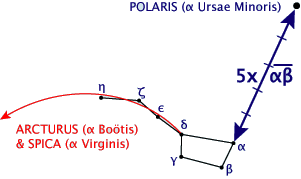
One of the most useful asterisms in the night sky is the Big Dipper in Ursa Major, known by many different names around the world: the Plow in the UK, the Big Rudder in Vietnam, and the Caribou to the Inuit, to name just a few. Using its stars, you can guide yourself to many of the fascinating deep sky objects you might want to see in your binoculars or telescope.
The Big Dipper itself has a binary star, Mizar and Alcor, which is seen as the middle star in the handle of the Dipper. On exceptionally clear nights, you may be able to split, or resolve, the pair of stars with the unaided eye. In the pre-telescope era, this binary was used as a test of eyesight.
Early telescopic observations of Mizar revealed that it was a binary star, and even more powerful telescopes revealed that each component of the binary system was itself a binary system. Also, Alcor is a binary. So there are a total of six stars in the area, but you will need a telescope to see more than two of them. I did a simulation using Stellarium and you can split Mizar itself, by using a 14-inch (350-millimeter) telescope at several hundred power. So it’s possible but not easy.
Now if you want to use an equatorial mount effectively, you need to know where Polaris is, as Polaris marks the north celestial pole. I wouldn’t recommend an equatorial mount for beginners or visual observing in general as they are non-intuitive, and the ones that come with beginner telescopes are, well, flimsy. But they are essential for astrophotography if you want to get long exposure pictures without star trailing.
The Big Dipper can also help you locate Polaris easily. Look north in the night sky to find the Big Dipper. Then find the two stars opposite the handle – Merak and Dubhe – and follow a line heading away from the star in the bottom right about three times the distance between those two stars. Or just away from the horizon if that’s easier. As the night goes on, the sky itself will appear to rotate counterclockwise around Polaris. Early in the evening, it will be straight up from Dubhe. Later in the evening, Polaris will be towards the horizon from two stars in the Dipper, and just before sunrise, you’ll need to look towards the east to find it.
The Big Dipper is useful for finding more than just Polaris. There is a classic mnemonic “arc to Arcturus, speed to Spica” where one follows the direction of the handle towards those stars. Arcturus is in the constellation Böotes which is kinda boring, but Spica is in Virgo which is rich in deep-sky objects. On either side of the star at the end of the handle, Alkaid, are the galaxies M101 and M51. The equally impressive galaxies M81 and M82 are found simply by following a diagonal line from the bottom left to top right star and continuing up twice that distance.
We’ll have links to star charts for the Big Dipper and Virgo in our show notes, which you can find at DailySpace.org. Print one out, head outside, and look up.
More Information
Use Big Dipper to find North Star (EarthSky)
“Parallactic Motion for Companion Discovery: An M-Dwarf Orbiting Alcor,” Neil Zimmerman et al., 2010 January 6, The Astrophysical Journal




 Join the Crew!
Join the Crew!
 Escape Velocity Space News
Escape Velocity Space News
0 Comments